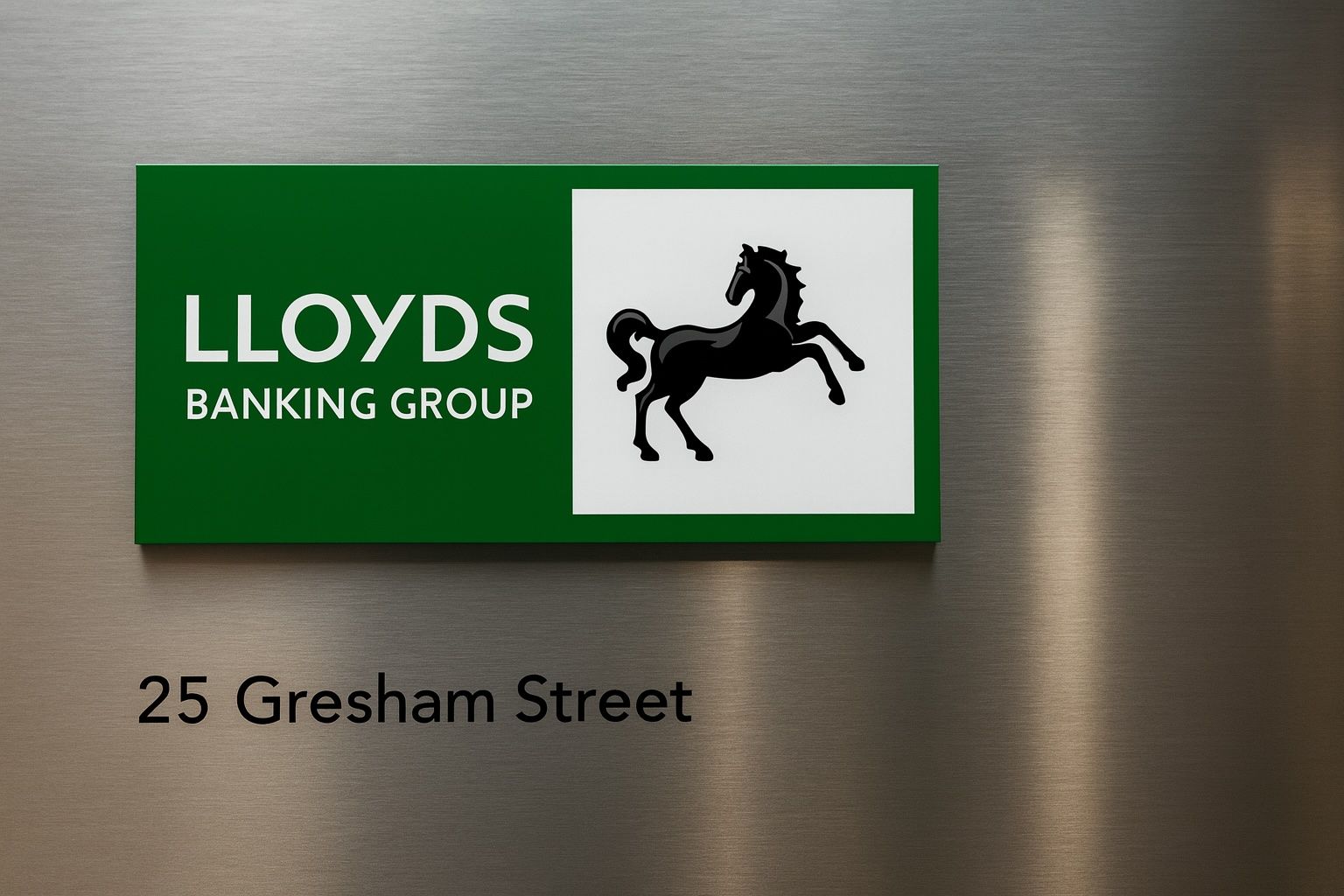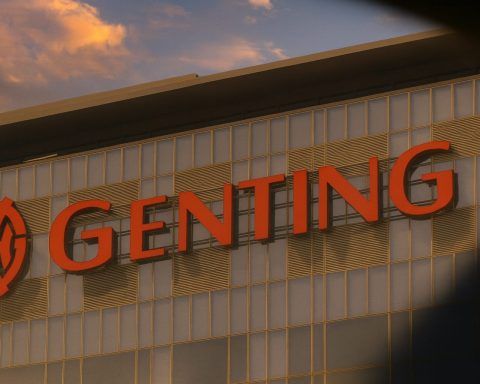Lloyds Banking Group’s share price edged lower on Wednesday 19 November 2025, as investors digested a busy news day that included the acquisition of fintech Curve, a restructuring of the bank’s trading operations and fresh UK inflation data that could signal lower interest rates ahead.
Lloyds share price snapshot for 19 November 2025
As of the London market close on Wednesday:
- Lloyds Banking Group (LON: LLOY) was trading around 88p per share, modestly lower on the day – roughly a 1% decline versus Tuesday’s close of 89.08p. [1]
- Intraday trading range: approximately 87.45p to 89p, showing a relatively tight band as the market absorbed the news flow. [2]
- Volume was in the region of 35–36 million shares, slightly above the stock’s average daily turnover. [3]
- Over the past 12 months, Lloyds shares have traded between about 52.4p and 95.7p, leaving today’s price well above the year’s low but around 8–10% below recent highs. [4]
- The move leaves Lloyds with an estimated market capitalisation of around £52–53bn. [5]
Different data providers can show small variations (for example, around 88.1p vs 88.0p as the closing level), but they all point to a roughly 1% fall for Lloyds on 19 November 2025. [6]
1. Curve acquisition dominates today’s Lloyds headlines
The main corporate story driving Lloyds news today is its move to buy Curve, a London‑based fintech whose digital wallet aggregates multiple payment cards and alternative payment methods into a single app, adding budgeting, cashback and “money‑saving” features. [7]
Deal details and strategic rationale
Lloyds announced that it has agreed to acquire Curve UK Ltd, describing the transaction as a strategic step to accelerate the group’s digital transformation and enhance its mobile banking experience. [8]
Key points from today’s announcements and media coverage:
- Curve’s proposition: it runs a digital wallet that lets users store multiple debit and credit cards in one secure app, with features like rewards, cashback, spending analytics and the ability to move past transactions between cards. [9]
- Scale and regulation: Curve processes billions of pounds in payments each year and is authorised and regulated in both the UK and the European Economic Area. [10]
- Price tag (reported): Lloyds has not disclosed the financial terms, but multiple reports today repeat earlier indications that the price is around £120m, based on prior Sky News reporting cited by business media. [11]
- Financial impact: Lloyds says the deal is not expected to have a material impact on its capital position or on guidance for 2025 and 2026, signalling that this is primarily a strategic, not earnings‑driven, acquisition. [12]
- Timing: completion is targeted for the first half of 2026, subject to regulatory approvals. [13]
By integrating Curve’s technology – including its Curve Pay wallet – into the Lloyds app, the bank aims to deepen customer engagement, particularly among digitally savvy users who currently rely on Apple Pay, Google Pay and challenger banks. [14]
Market reaction: mild scepticism baked into the share price
Commentary from market outlets today suggests investors broadly welcome the strategic intent but remain cautious:
- Live market coverage noted that Lloyds shares traded modestly lower even as the FTSE 100 moved slightly higher, with commentators linking the underperformance to initial profit‑taking after recent gains and uncertainty around the Curve deal’s payoff. [15]
- Some reports highlight concerns about integration risk and execution, as Curve has historically run at a loss while investing heavily in growth. [16]
In other words, the market seems to be treating the Curve acquisition as a long‑term digital bet, not an immediate driver of earnings – which helps explain why the share price dipped slightly despite the positive strategic spin.
2. Trading and underwriting shake‑up adds another talking point
Alongside the Curve deal, Lloyds is in the spotlight today for a major reorganisation of its markets business.
According to reports, the bank plans to merge its trading, financing and corporate sales teams into a single global markets division, part of a broader effort to sharpen its presence in capital markets and institutional banking. [17]
Key elements of this restructuring news today:
- The new division will cover markets activities across the UK, North America and Europe. [18]
- Senior leadership changes are coming, including the planned departure of the group’s head of capital markets in 2026 and the appointment of a new CEO for corporate and institutional banking. [19]
- The restructure is positioned as part of CEO Charlie Nunn’s strategy to grow in capital markets, insurance and wealth, building on profit growth in the corporate markets division over recent years. [20]
For the share price, this type of story tends to cut both ways:
- Positive: it signals ambition and may drive higher fee income and better use of balance sheet over time.
- Negative / uncertain: restructuring creates short‑term execution risk, potential one‑off costs and management distraction – all factors that can keep some investors on the sidelines.
Combined with the Curve deal, today’s announcements underline that Lloyds is actively reshaping its business, which can make the share price more volatile as the market reassesses long‑term earnings power.
3. Share buyback continues around today’s price level
Today’s trading also sits against the backdrop of a large ongoing share buyback, which has been a key support for the Lloyds share price through 2025.
- A fresh update shows the bank recently repurchased over 10.7 million ordinary shares at a volume‑weighted average price of about 88.55p, with the intention of cancelling them. [21]
- This forms part of a multi‑billion‑pound buyback programme first outlined with Lloyds’ 2024 results, aimed at returning surplus capital to shareholders and keeping its core capital ratio near target levels. [22]
The interesting detail for today: the buyback prices are broadly in line with where LLOY traded on 19 November, reinforcing the idea that management sees value in retiring shares at around the high‑80s pence level. [23]
For investors, buybacks can:
- provide downside support to the share price when markets are choppy;
- boost earnings per share over time by reducing the share count;
- signal confidence from management in the bank’s capital strength and long‑term outlook.
However, they do not remove fundamental risks, particularly around regulation and credit quality.
4. Macro backdrop: softer UK inflation and rate‑cut expectations
Today’s move in Lloyds shares also came against a big macro headline:
- UK CPI inflation fell to 3.6% in October 2025, down from 3.8% in September – the first easing in five months, according to official data released this morning. [24]
This has a nuanced impact on banks like Lloyds:
- Lower inflation and expectations of earlier Bank of England rate cuts can weigh on bank stocks, because the powerful tailwind from higher interest margins may start to fade if rates fall faster or further than expected. [25]
- At the same time, slower inflation and the prospect of cheaper borrowing costs are supportive for households and small businesses, potentially reducing credit risk and supporting loan demand over time.
Market reports today described European equities as mixed, with the FTSE 100 making only small gains despite the softer inflation data – and specifically noted Lloyds trading slightly in the red after its deal news. [26]
Put simply: macro tailwinds are cooling, and investors are watching closely to see how quickly rate‑cut expectations feed through to UK bank margins.
5. Legacy headwinds: car finance scandal and regulatory risk
Behind today’s headlines, the Lloyds story is still influenced by longer‑running issues that investors haven’t forgotten:
- In late October, Lloyds reported that quarterly profit had fallen sharply after setting aside an additional £800m for potential car‑finance mis‑selling claims, linked to a UK regulatory probe into historic motor finance commission practices. [27]
- Over the last year, the bank has taken close to £900m in remediation charges on this issue, based on earlier results disclosures. [28]
That backdrop matters for the share price because:
- It caps enthusiasm: even when Lloyds reports strong underlying profits, investors worry that additional provisions or regulatory changes could erode returns.
- It influences how the market reads new strategic moves like the Curve acquisition – some may ask whether the bank should prioritise resolving regulatory issues over making fresh deals.
So while today’s drop is modest, it sits on top of a multi‑quarter narrative in which car‑finance risk and regulation have been a recurring theme in the Lloyds investment story. [29]
6. How does today’s price fit into the bigger 2025 picture?
Despite today’s dip, 2025 has so far been a strong year for the Lloyds share price:
- Over the past 12 months, the stock has delivered around 60% share price appreciation, helped by rising rates, resilient credit quality and the ongoing buyback programme. [30]
- The current price in the high‑80s pence region leaves the shares:
- well above the 52‑week low near 52p;
- around high single digits below the 52‑week high just under 96p set earlier in November. [31]
On simple valuation measures:
- Lloyds trades on a mid‑teens price‑to‑earnings (P/E) multiple and offers a dividend yield of roughly 3–4%, based on current share price and recent dividend history. [32]
Those numbers place the bank roughly in line with, or slightly below, many global peers, reflecting both its attractive capital returns and its exposure to UK‑specific political and regulatory risk. [33]
7. What to watch next for the Lloyds share price
For anyone tracking LLOY into the coming days and weeks, several catalysts emerge from today’s news:
- Regulatory approvals and integration plans for Curve
- Investors will want more detail on how quickly Curve’s features will appear inside Lloyds’ main apps, what the integration costs will be, and whether Curve continues to operate as a distinct consumer brand. [34]
- Further information on the global markets restructure
- Any update on headcount changes, one‑off restructuring charges or new profitability targets for the merged trading and underwriting business could move the shares, positively or negatively. [35]
- BoE interest‑rate decisions after the latest inflation print
- Today’s data have strengthened market expectations for a possible December rate cut, but policymakers remain divided. Upcoming Bank of England communications will be key for all UK bank stocks, including Lloyds. [36]
- Progress (and any surprises) on the car‑finance probe
- Additional provisions, new regulatory announcements or legal developments could have a material impact on sentiment, even if underlying earnings remain strong. [37]
- Continuation of the share buyback
- Daily buyback disclosures give a useful signal on how aggressively Lloyds is buying at current price levels, and how much “technical support” the programme might be giving to the share price. [38]
Bottom line
On 19 November 2025, the Lloyds share price eased back to around 88p, with the stock modestly underperforming the wider FTSE 100 despite a landmark digital wallet acquisition and ongoing buybacks. [39]
Today’s modest decline looks less like a fundamental change of direction and more like the market re‑pricing near recent highs in response to:
- a strategic but not yet earnings‑accretive deal for Curve,
- a complex trading‑business restructure, and
- a cooling macro tailwind as UK inflation falls and rate‑cut talk grows louder.
As always, this overview is for information only and is not investment advice. Anyone considering buying or selling Lloyds shares should look at their own financial situation, risk tolerance and, ideally, seek independent professional advice.
References
1. uk.investing.com, 2. uk.investing.com, 3. uk.investing.com, 4. www.investing.com, 5. stockanalysis.com, 6. uk.investing.com, 7. www.curve.com, 8. www.marketscreener.com, 9. www.curve.com, 10. fxnewsgroup.com, 11. www.bloomberg.com, 12. www.rttnews.com, 13. uk.investing.com, 14. www.investing.com, 15. www.proactiveinvestors.co.uk, 16. www.banking-gateway.com, 17. www.privatebankerinternational.com, 18. www.fnlondon.com, 19. www.fnlondon.com, 20. www.fnlondon.com, 21. www.tipranks.com, 22. www.reuters.com, 23. uk.investing.com, 24. www.reuters.com, 25. www.reuters.com, 26. uk.finance.yahoo.com, 27. www.theguardian.com, 28. www.reuters.com, 29. www.theguardian.com, 30. www.investing.com, 31. www.investing.com, 32. www.hl.co.uk, 33. simplywall.st, 34. www.investegate.co.uk, 35. www.fnlondon.com, 36. www.reuters.com, 37. www.theguardian.com, 38. www.tipranks.com, 39. uk.investing.com










